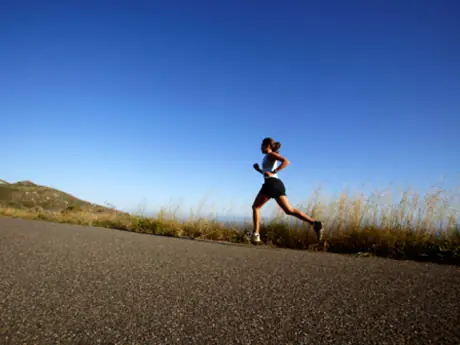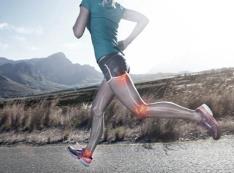
When running turns into a literal pain in the butt, it's time to step back and examine where that discomfort may be rooted. Oftentimes, this type of soreness is diagnosed as piriformis syndrome. Marked by a dull ache and tightness in the gluteal muscles and oftentimes pain radiating down the back of the leg, it can range from a low-level irritation to a sidelining injury.
What Is Piriformis Syndrome?
One of the more difficult injuries to diagnose, piriformis syndrome results from injury to or inflammation of the piriformis muscle. Located in the hip region, the piriformis is an important stabilizer muscle. "It keeps your pelvis and sacrum level and prevents your hips from internally rotating," explains Mike Orzechowski, a Fort Washington, Pennsylvania-based physical therapist and running specialist. "If you have weakness of the piriformis and glute muscles, that increased internal rotation of the hip can lead to issues and irritate the piriformis."
More: 11 Exercises to Boost Hip Strength
Piriformis Syndrome vs. Sciatica
The difficulty in diagnosis is usually related to the similarity in symptoms between piriformis syndrome and sciatica. While sciatica is perhaps most commonly caused by a herniated disc or spinal degeneration, it can also be a result of an irritated piriformis muscle compressing the sciatic nerve. Since the nerve runs close and sometimes through the piriformis, dysfunction of the piriformis can actually cause sciatica. With that said, the pain and numbness down the back of the leg that comes with sciatica isn't always a result of piriformis syndrome. According to a recent literature review on the subject, piriformis syndrome encompasses pain and stiffness in the piriformis muscles, as well as the classic symptoms of sciatica if the muscle is irritating the nerve.
Piriformis Syndrome Diagnosis
While each case is different, Orzechowski will usually have a patient he suspects has piriformis syndrome do an eccentric step down test to determine if there is weakness in that area. This simply involves standing on a step or platform on one foot and bending that knee to lower the other foot down toward the ground. If the knee of the standing leg turns inwards, it suggests there is weakness in the piriformis and surrounding muscles.
"Running is a straightforward motion, so a lot of runners forget to do cross-training and lateral exercises like lateral lunges to work those muscles," he explains. "If those hip muscles are weak and you continue to add mileage, it can become an overuse issue."
More: 7 Cross-Training Exercises for Runners
Piriformis Syndrome Stretches
1. Ankle-Over-Knee Stretch
Lie flat on your back with both knees bent and feet flat on the ground. Bring one foot up and cross your ankle over your opposite knee. Grab the back of the thigh of the leg still on the ground and gently pull it towards your chest.
2. Bridge Stretch
Lie flat on your back with both knees bent and feet flat on the ground. Squeeze your core and buttocks to lift your hips off the ground. Hold for a few seconds, then lower slowly back down. Repeat 10 times.
3. Clamshell Stretch
Lie on your side with knees bent and ankles stacked. Lift your top knee while keeping your heels together, then lower down slowly. Perform 10 reps on each side.
4. Lying T-Stretch
Lie on your back with both arms extended straight, perpendicular to your body. Bend your knees and rotate them to one side, keeping your legs together. Move slowly, holding the stretch on each side for 5-10 seconds. Perform 10 reps on each side.
5. Air Squats
Stand with your heels shoulder-width apart. Sit back and lower down into a low squat, keeping your spine straight. Slowly stand. Perform 10 reps.
Piriformis Syndrome Treatment
If you're diagnosed with piriformis syndrome, your running prospects will vary depending on the severity of the issue. "If it's something that has just started, I hate to shut anyone down if they want to run," says Orzechowski. "If they have had it for a year and there is pain going down the leg, I'm going to tell them to stop running."
One of the main issues with piriformis syndrome is that runners will take time off to let the injury heal, but then experience a recurrence as soon as they ramp up mileage again. This is a result of not doing the proper strength work that will prevent the problem in the first place. "If your core is weak, all those muscles around it can't work effectively because that's your base," he adds. "When your core is strong, everything activates properly."
A recent review published in the Journal of Evolution of Medical and Dental Sciences simply suggests a regimen of anti-inflammatories, rest and ice in treating piriformis syndrome. In addition to core strength work, including the hip abductor and adductor muscles, stretching the area may also provide pain relief. This can be done through static stretching or foam rolling, depending on the athlete.
More: Foam Rolling Tips & Exercises
Orzechowski also often prescribes myofascial trigger point release and Graston Technique to treat affected athletes. "We use a variety of myofascial techniques to get in there and decrease pressure on the sciatic nerve and calm down the piriformis," he says. These therapies allow the clinician to be more exact in targeting the area of interest. While foam rolling can further irritate the sciatic nerve if you compress it as you work to stretch and massage the hip and glute region, trigger point therapy and Graston allow for scar tissue and muscle dysfunction to be pinpointed more accurately.
More: Therapies to Help You Get Past Your Nagging Injuries
Injectable treatments, including local anesthetic and cortisone, are also sometimes recommended by doctors, although the results are generally variable. In most cases, manual treatments done in physical therapy, as well as a commitment to strengthening and stretching, will have you back on your feet in no time.
To be sure, since this is a complicated injury, if you're having persistent pain in your backside that is preventing you from running, it's time to see a specialist. By coming up with a solid treatment plan, a physical therapist is usually the fastest route to getting back out and running healthy again.
READ THIS NEXT: How to Treat and Prevent Lower Back Pain for Runners
Piriformis Syndrome FAQs
What is the fastest way to treat piriformis syndrome?
A combination of physical therapy, light exercise, and stretching is recommended for the treatment of piriformis syndrome. Certain medications may help treat associated pain.
Can stretching make piriformis syndrome worse?
Aggressive stretching can worsen piriformis syndrome symptoms. It is important to perform stretches slowly and gently. Listen to your body and avoid holding positions that result in sharp pain.
What causes piriformis syndrome?
Piriformis syndrome is caused by a muscle spasm in the piriformis muscle. This spasm is the result of either irritation of the muscle or a nearby structure, like the sacroiliac joint or hip. Runners often experience piriformis syndrome as a result of overloading or overuse due to running beyond your body’s training tolerance.
Get ACTIVE on the Go


Couch to 5K®
The best way to get new runners off the couch and across the finish line of their first 5K.
Available for iOS | Android







Discuss This Article